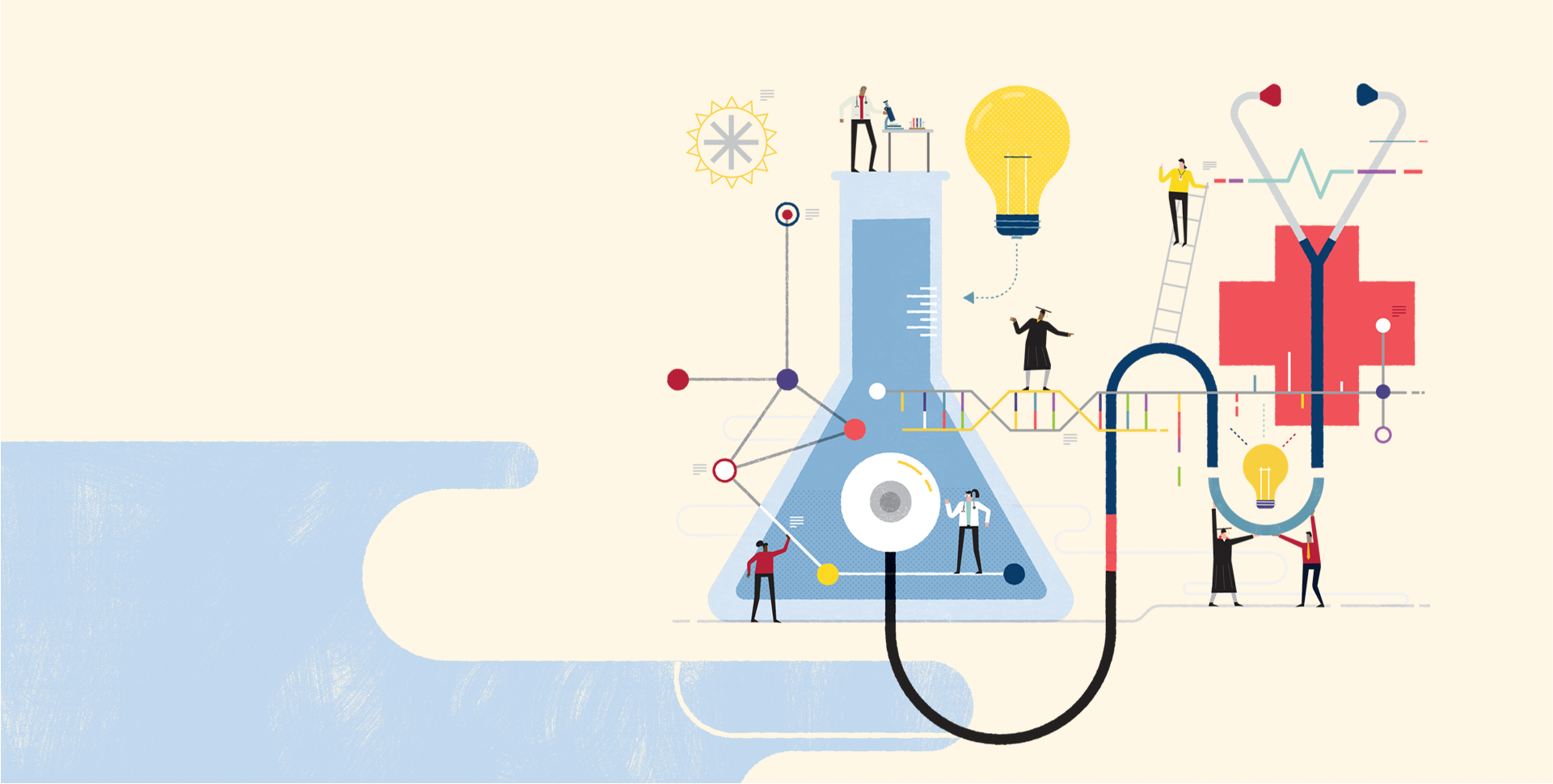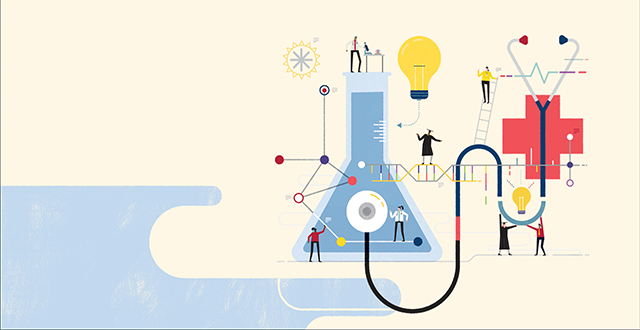

Powerhouse Partnership
FAU and Memorial Healthcare System Join Forces to Take Health-Related Research to the Next Level
By Wynne Parry
A new partnership between FAU and Memorial Healthcare System unites doctors, scientists and engineers in the fight against disease. It promises to advance research with the potential to improve healthcare and save lives in South Florida, across the state and beyond. It also aims to make the cutting-edge care accessible to patients closer to home.
The collaboration is a “win-win,” according to Daniel Flynn, Ph.D., FAU’s vice president for research. “As a public research university, there are certain things we do very well, and as a major hospital system, there are certain things they do very well. We are bringing together the best from both sides.”
Faculty members at both institutions already conduct research, but generally in different arenas. The new affiliation agreement bridges their efforts, making it easier for university scientists and engineers to share resources and expertise with doctors seeking to better help their patients.
Studies on the university’s side cover the full spectrum of research — identifying compounds with anti-cancer properties, developing new tools for making sense of data or for coping with the effects of dementia, for example. Many such projects have the potential to one day influence the care patients receive, if developed with input from doctors, nurses and others working in health care.
Memorial, which operates six hospitals plus other facilities in Broward County, strives always to put the patient first and in this spirit, encourages its doctors to take on research projects. The healthcare system’s strength lies in a special class of studies: clinical trials, which test devices and drugs to see if they are safe and effective. At any given time, Memorial’s Office of Human Research typically has more than 150 clinical trials underway.
By volunteering for these studies, patients can have access to therapies that they couldn’t get as part of their routine care. Ultimately, the healthcare system aims to have a trial available for each one of its patients, said Candice Sareli, M.D., Memorial’s chief medical research officer.
“We have become more academic, and we have done so in order to meet the needs of the growing community we serve in South Florida,” Sareli said. “A true research collaboration with the university allows us to expand our reach in the academic area.”
Mutual Benefit
The collaboration creates new opportunities for both sides. For its part, Memorial wants to become more involved in an earlier phase of research: translational studies, which adapt the discoveries made in labs, turning them into therapies doctors can use to help patients.
The healthcare system also hopes to collaborate with computer scientists to find new ways to extract meaningful information from its extensive patient databases, and to partner with engineers to develop medical devices and software, she says.
In turn, faculty at FAU are interested in collaborating with Memorial’s doctors on clinical trials, as well as other types of studies. As one of the largest public healthcare systems in the United States, Memorial has ready access to potential study volunteers — a resource that’s often in short supply for university researchers who need to work with people, their samples or data.
Prior to the partnership, FAU researchers found volunteers using a grab bag of tactics: reaching out to nearby hospitals and doctors’ offices, setting up tables at community events, posting flyers and advertising on social media.
In these searches, they get support from the Clinical Research Unit (CRU). Located on the Boca Raton campus, the CRU helps researchers navigate the complex logistics of running these studies and provides space for them in its first-floor clinic.
“Recruitment is one of the biggest challenges in clinical research,” said Ximena Levy, M.D., M.P.H., director of the CRU. While researchers will likely continue to use many means to find participants, “the partnership will help by giving them a specific population to invite to the studies,” she said.
Levy estimates that, as a result, clinical research at FAU will increase by 30 to 50%.
When the partnership recently became official, some university researchers were already laying the groundwork for new collaborative projects, many on a topic of common interest to both institutions: cancer.
New Breast Cancer Resource
The laboratory in the CRU’s building may become home to one such effort: a collection of specimens from breast tumors, taken from cancer patients at Memorial and elsewhere. As it fills, Levy anticipates that this repository will provide the raw material for new research on the disease.
“A resource like this is not currently available, so I think that is one of the projects that is going to be most important for both institutions,” she said.
Initially, a team of FAU and Memorial researchers intends to use these samples, drawn from South Florida’s diverse population, to tease out the disease’s characteristics by race and ethnicity.
Such heritage appears to matter in this disease. White women, for example, develop new cancers at a higher rate, meanwhile women of African heritage are more prone to an aggressive form of the disease. Researchers want to know how these dynamics play out for Hispanic women, who can have European, Indigenous American and African ancestry.
Test the Test
In pancreatic cancer, tumors typically aren’t identified until they spread to other parts of the body. To improve patients’ prospects, biomedical engineer Waseem Asghar, Ph.D., is developing a test to detect bits of genetic material that may be present early on in the disease.
Work so far has been promising, but to see if the test really works, his team needs samples from at least 100 patients with cancer, as well as at least 100 without, said Asghar, an associate professor in the College of Engineering and Computer Science. He has begun discussions with the Memorial Cancer Institute about finding those patients.
Another, even newer project focuses on COVID-19. Using magnetic beads and tiny, water-filled chambers, Asghar is devising an easy-to-use, disposable test capable of detecting the virus in a drop of saliva within 30 minutes. As with the cancer test, his team will need to validate it with samples from patients
Having also worked on Zika, sickle cell anemia, HIV and hepatitis C, Asghar sees the partnership as a valuable resource. “There are tons of different diseases with which we’ll be needing help,” he said. “Every year, we have some new bug to deal with.”
More Sustainable Exercise
Not all innovations involve molecules or devices. Michael Zourdos, Ph.D., and his graduate students have developed a way to tailor exercise specifically for cancer patients.
Cancer patients often experience rapid and dangerous weight loss known as cachexia, which can strip their bodies of muscle. They must also cope with fatigue brought on by treatment and the disease’s emotional burden.
By designing a flexible strengthening regimen, Zourdos, an associate professor in the Charles E. Schmidt College of Science, and his team aim to enable cancer patients to exercise more consistently. Their goal is that patients will gain muscle, improve quality of life and better tolerate chemotherapy and radiation.
Each workout begins with an assessment of how a patient feels, and their responses determine the intensity of the exercise.
A seven-patient pilot study, conducted with colleagues from Ohio State University and Boca Raton Regional Hospital, produced promising results. Zourdos has submitted a grant application for a larger 200-patient trial, this time in collaboration with a physician at Memorial.
“It just seemed like a natural fit going forward,” Zourdos said. “As soon as we reached out, they were as excited to work together as we were.” ◆